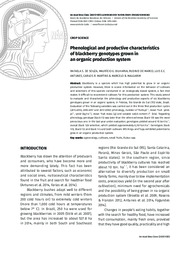Phenological and productive characteristics of blackberry genotypes grown in an organic production system.
Phenological and productive characteristics of blackberry genotypes grown in an organic production system.
Author(s): SOUZA, R. S. de; BILHARVA, M. G.; DE MARCO, R.; ANTUNES, L. E. C.; MARTINS, C. R.; MALGARIM, M. B.
Summary: Blackberry is a species which has high potential to grow in an organic production system. However, there is scarce information on the behavior of cultivars and selections of this species conducted in an ecologically based system, a fact that makes it difficult to recommend cultivars for this production system. This study aimed to evaluate and characterize the phenology and productive aspects of six blackberry genotypes grown in an organic system, in Pelotas, Rio Grande do Sul (RS) state, Brazil. Evaluation of the following variables was carried out in the three first production cycles (2015-2016, 2016-2017 and 2017-2018): phenology, number of fruits.pl?¹, mean fruit yield.pl?¹, yield (kg.ha?¹), mean fruit mass (g) and soluble solid content (° Brix). Regarding phenology, genotype Black 112 was later than the others whereas Black 178 was the most precocious one. In the last year under evaluation, genotypes yielded around 10 ton.ha?¹, except Black 128 selection, which yielded approximately 6,767 ton.ha?¹. Genotypes Black 178, Black 112 and Black 145 and both cultivars BRS Xingu and Tupy exhibited potential to grow in an organic production system.
Publication year: 2021
Types of publication: Journal article
Keywords: Amora Preta, Sistema de Cultivo
Observation
Some of Embrapa's publications are published as ePub files. To read them, use or download one of the following free software options to your computer or mobile device. Android: Google Play Books; IOS: iBooks; Windows and Linux: Calibre.
Access other publications
Access the Agricultural Research Database (BDPA) to consult Embrapa's full library collection and records.
Visit Embrapa Bookstore to purchase books and other publications sold by Embrapa.

